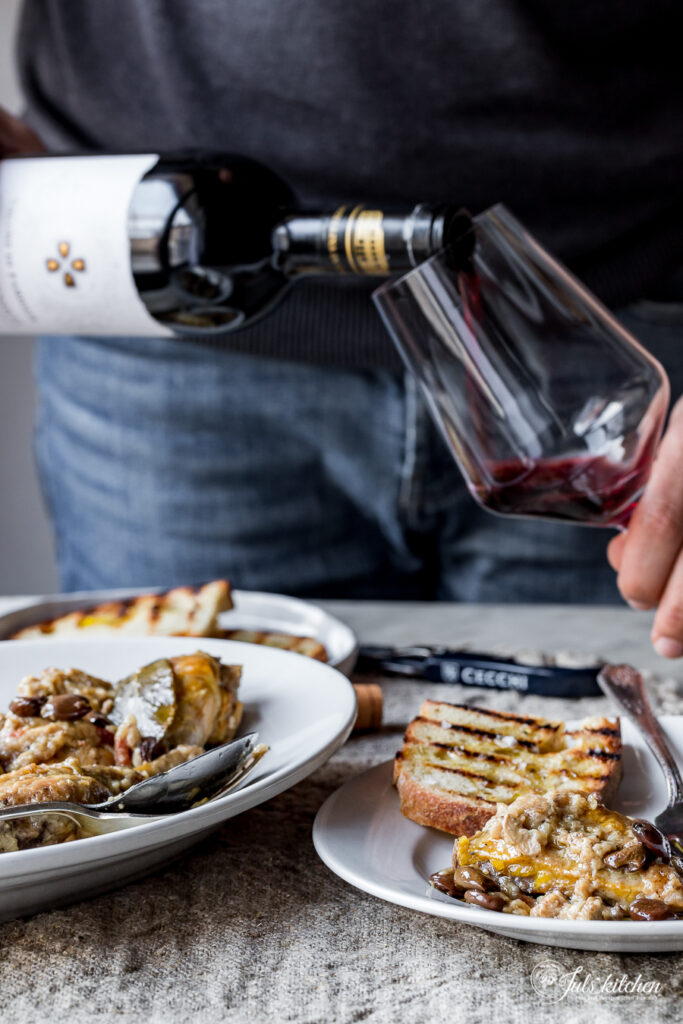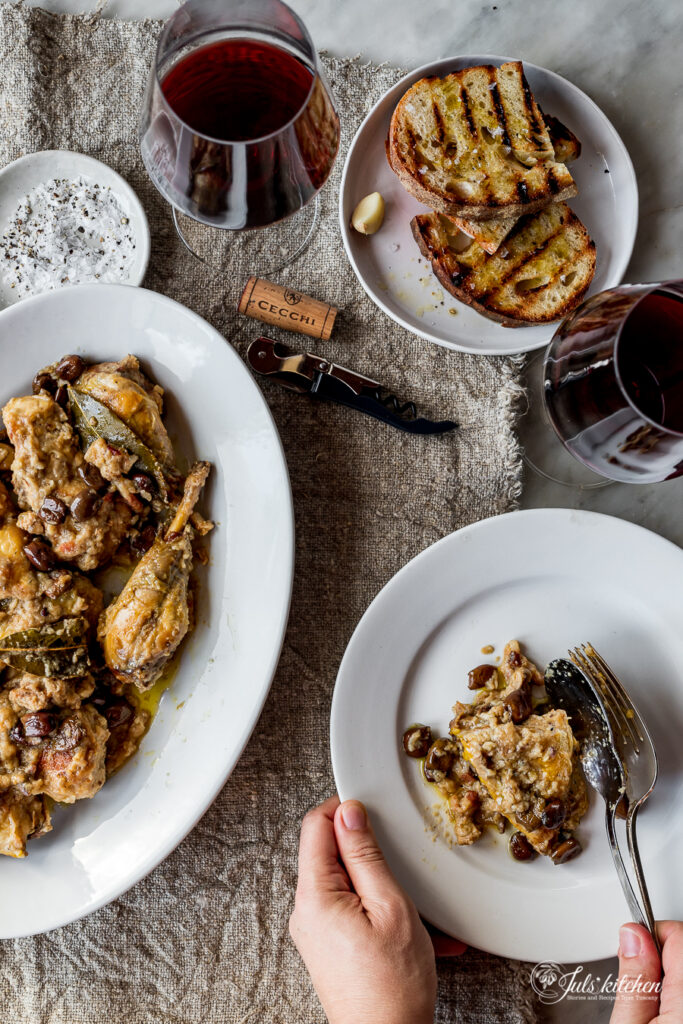Stewed Guinea fowl. Holidays and conviviality
The moments when I’ve felt safer in my life are at the table, with my large family gathered around a simple fare. At the table, I’m a mother, a daughter, a sister, a granddaughter, I’m a wife, stealing a perfectly roasted potato from Tommaso’s plate; I’m my Aunt’s niece when she serves me an extra portion of her lasagne; I’m an aunt, too, when my niece wants to sit just next to me, whispering in my ear all her secrets. I have a role, I have meaningful connections, I have a safety net.
Call it a cliché, but I’m Italian, and I love conviviality, I love rituals and all the family habits that involve food and seasonality. This is probably one of the reasons why I can’t wait for big holidays to come.
I am always keen on adopting new traditions to add a sense of time, a reason to celebrate and cook something that has a deeper meaning for us as a family.
That’s why I’ve been baking a British Christmas cake for 10 years now. First, I tried Jamie Oliver’s recipe – the one you can find in one of the most commented posts on this blog – then Nigel Slater’s recipe from The Christmas Chronicles, and eventually my friend Regula Ysewijn’s fruit cake, the one she had for her wedding, as she shared it in her cookbook Oats in the North, Wheat from the South. I tried it out of curiosity, then adopted it for the ritual of baking it when Christmas is still out of sight, feeding it with brandy through the weeks that slowly lead us to the holidays.
Visualizza questo post su Instagram
When I met Tommaso, his Apulian traditions crept into my way of celebrating.
I started making pittule on the eves of important holidays: after all, do you need an excuse to fry pillowy bread dough morsels studded with olives, tomatoes, capers, and anchovies? I’m also slowly adding new family rituals belonging to Salento as a way to remember Lucia, his mum, who passed away last year. I made it my mission: it is my way to get to know her better through the flavours and the traditions of her homeland, and a way to pass all these memories on to Livia.
I have never celebrated Thanksgiving in America, but from what I gathered from movies, books, and all the exchanges we had over a large, relaxed meal during our cooking classes, it would be right up my alley. It is probably the conviviality I would appreciate more, the family traditions, the long wait to eat your Aunt’s favourite dish, or the quirkiness of that family habit that happens again and again over the years.
And so, for the upcoming Christmas, but also for Thanksgiving, I want to put aside the sense of inadequacy, the stress of wanting to impress at all costs, the cooking marathons and the crazy shopping, the exasperation of being – or appearing – perfect, on Instagram and in real life. Instead, I just want to make room for conviviality.

Conviviality, for me, is all about sharing small rituals, building habits, cooking to nurture, not to impress.
There’s nothing better than when conviviality marries simplicity, so don’t stress over the menu. Whether you’ll be sitting around a long table or just with your other half, I can help you with some simple, reliable recipes, coming directly from my family cooking repertoire.
Today I’m sharing a recipe for Guinea fowl. It is as straightforward as a chicken to cook but with a more sophisticated flavour, making it closer to game meat than poultry. I made a ragù out of it, then I cooked it with oranges as if it were a duck. Now it is its time to shine in a deeply aromatic main course, cooked with wine, herbs, juniper, cloves, olives, and pancetta.
Recipes for conviviality
In our newsletter, Letters from Tuscany, I’m also sharing a small selection of my favourite recipes that are made for conviviality: big pots of ragù, both with beef and with lentils, wild boar stews, trays of crespelle, a turkey roast, and a few seasonal cakes. I hope you will enjoy them. You can read the latest issue here.
Before Covid, many of you had the chance to visit Italy more often or, at least, your dream to spend a month-long holiday touring small towns perched on a hill or nestled on the sunny Italian coast was more tangible.
The past two years broke habits and dreams, put a stop to conviviality, visits to small family-owned restaurants to learn recipes passed down from generations. Through our chats and messages, you told us that what you missed more was the conviviality of crowded tables, the inspiration you could get from a trip to a small market where apparently everyone knew each other.
When we first launched our subscription-based newsletter back in March, we thought it was mainly about sharing recipes. We could not believe it could become for you an anchor to Italy, to the Italian table and our loud conviviality, a reason to experiment with less known ingredients, the voice of a friend in the kitchen. Join us here.

Faraona in salmì – Stewed Guinea fowl
Recipe developed in collaboration with Cecchi.
The history of Cecchi began in 1893 with Luigi Cecchi, an extremely talented wine taster. The Cecchi soon became famous abroad for their skills. In the 1970s they moved to Castellina in Chianti, in the area historically renowned for the production of Chianti Classico, and there they began their winemaking adventure. In the following years, they expanded their production areas to include San Gimignano, where they produce a renowned local white wine, Vernaccia, and Maremma.
The wine we chose for today’s recipe is Valore di Famiglia, a Chianti Classico Gran Selezione D.O.C.G. produced in Castellina in Chianti. With a soft ruby red colour, very delicate, it has a velvety start that develops in a wide envelopment. It is a perfect wine for a roast, game, and aged cheese.
We thought about faraona in salmì, stewed guinea fowl, a dish that for us has a strong sense of family, of festive days worth celebrating, a recipe whose aromas are very close to game meat, but that is at the same time accessible and easy to make.
Salmì is a way of cooking game meat – hare, roe deer, deer, wild boar, pheasant, and partridge. First, you marinate overnight the meat in wine, herbs, and spices, then you roast it with the same aromas, pancetta, and olives. You can also prepare the stewed guinea fowl in advance, and gently reheat it before serving.
Faraona in salmì – Stewed Guinea fowl
Ingredients
- 1 guinea fowl, already cleaned and cut into 12 pieces, approx. 1.5 kg (3.3 lb)
- 1 celery stalk, chopped
- 1 carrot, chopped
- 2 bay leaves
- 2 cloves garlic, crushed
- 1 sprig of thyme
- 1 teaspoon juniper berries
- 2 cloves
- 470 ml dry white wine
- 4 tablespoons all-purpose flour
- 4 tablespoons extra virgin olive oil
- 100 grams pancetta, cut into strips
- 240 ml vegetable stock or lightly salted hot water
- 80 grams pitted olives
Instructions
- Clean the guinea fowl and place them in a large, shallow bowl. Add the celery, carrot, bay leaves, crushed garlic, thyme, juniper berries, and cloves, then cover with the wine. Close the bowl with cling film and refrigerate for 12 to 24 hours.
- After this time, remove the guinea fowl from the marinade and pat each piece of guinea fowl dry. Next, strain the wine into a bowl and set aside the bay leaves and the juniper berries.
- Coat the guinea fowl pieces with flour and set them aside.
- Pour the olive oil into a large frying pan, add the pancetta, and brown it over medium heat.
- Add the guinea fowl to the pan, brown it on both sides, then pour in the wine and reduce over medium-low heat. This will take about 10 minutes.
- Pour in the hot stock, or the slightly salted hot water, in two or three times, and cook, covered, for about 30 minutes over low heat.
- Now add the olives and the finely chopped liver and heart, and finish cooking the guinea fowl over low heat for the last 10 minutes.
- Add salt and pepper to taste and serve immediately.
- You can also prepare the guinea fowl a little in advance; just reheat it over low heat before serving.
Notes











Comments (0)